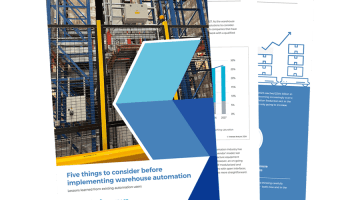Grocery Fulfillment: What is the Right Solution?
Pre-pandemic, the grocery supply chain was primarily traditional with regional distribution centers supplying products to retailers for in-store shoppers. A few of the largest grocery chains were starting to experiment with advanced automation. However, the pandemic led to a dramatic increase in online grocery buying with pickers walking store aisles to fill orders. This expensive and labor-intensive means of order fulfillment created a large amount of traffic in the store and often long wait times for curbside pickup.
It is forecast that online grocery buying will go from trial to habit for many US shoppers, with estimates between 10% and 20% of all grocery purchases to be online in the next five years. Most grocery retailers still fulfill online orders through a manual process, but some are installing local micro-fulfillment centers as a method to scale quickly. Specialized online grocery delivery services have proliferated in the past year with some companies promising delivery in as little as 10 minutes, primarily in urban locations. These rapid grocery delivery companies have been swift to install micro-fulfillment centers that are highly automated and carry a reduced number of SKUs in order to fill orders quickly. As online customers begin demanding even faster service and more items per order, how can grocers respond and start to evaluate what automation options make sense for them?
First, a company must examine their current process model and analyze operations. Where can automation immediately help increase productivity and scalability, or reduce reliance on labor? Consider labor availability and costs, current and desired order fulfillment time, replenishment time, and potential customer order growth. In this way, a company can make a more informed decision on what automation makes sense or if a micro-fulfillment center could be installed in a backroom or dark store to meet current and future online order demands.
Secondly, start to investigate and evaluate different types of automation. From augmenting existing conveyance and sortation to more leading-edge robotics, the array of options can be overwhelming. You may wish to engage the services of a warehouse automation consulting firm to assist and create a data-driven analysis that can guide you. Automated Guided Vehicles (AGVs) and Autonomous Mobile Robots (AMRs) can be used to move pallets as well as smaller units, replacing the need for manually operated forklifts. Robots as a Service (RaaS) is an option to lease and deploy technology when it is needed for a cost-effective way to meet peak volumes. Robotic goods-to-person systems can speed up the order fulfillment process in a small footprint that uses less labor. Full micro-fulfillment systems can be implemented to provide rapid order fulfillment with reduced transportation costs as they can be deployed in smaller, localized markets.
As today’s shoppers carry forward their online grocery buying habit, retailers must quickly determine which automation options can have the fastest impact on meeting customer service demands. Automation can be used to enable growth, and when implemented effectively, it can augment existing jobs to create greater productivity, enable scalability, and support sustainable solutions in an ever-growing market.
Categories (tags):


